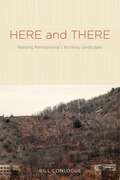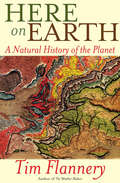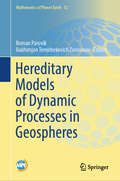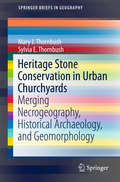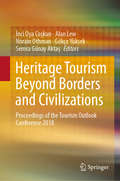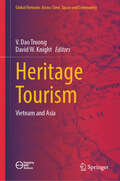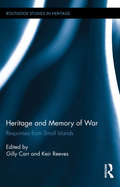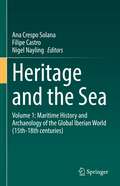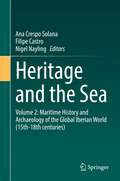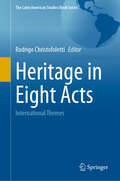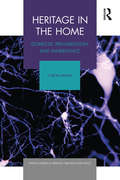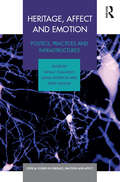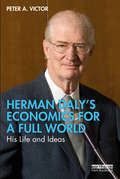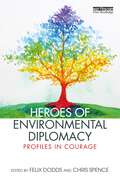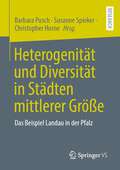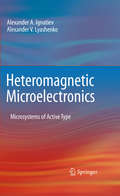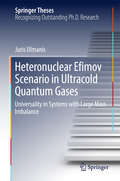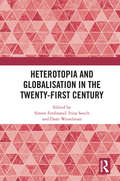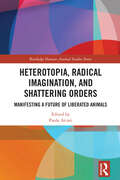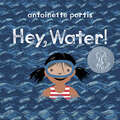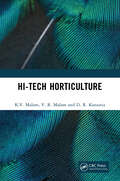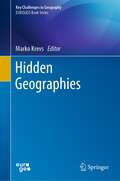- Table View
- List View
Here and There: Reading Pennsylvania's Working Landscapes
by Bill ConlogueThe global economy threatens the uniqueness of places, people, and experiences. In Here and There, Bill Conlogue tests the assumption that literature and local places matter less and less in a world that economists describe as “flat,” politicians believe has “globalized,” and social scientists imagine as a “global village.” Each chapter begins at home, journeys elsewhere, and returns to the author’s native and chosen region, northeastern Pennsylvania. Through the prisms of literature and history, the book explores tensions and conflicts within the region created by national and global demand for its resources: fertile farmland, forest products, anthracite coal, and college-educated young people. Making connections between local and global environmental issues, Here and There uses the Pennsylvania watersheds of urban Lackawanna and rural Lackawaxen to highlight the importance of understanding and protecting the places we call home.
Here and There: Reading Pennsylvania's Working Landscapes
by Bill ConlogueThe global economy threatens the uniqueness of places, people, and experiences. In Here and There, Bill Conlogue tests the assumption that literature and local places matter less and less in a world that economists describe as “flat,” politicians believe has “globalized,” and social scientists imagine as a “global village.” Each chapter begins at home, journeys elsewhere, and returns to the author’s native and chosen region, northeastern Pennsylvania. Through the prisms of literature and history, the book explores tensions and conflicts within the region created by national and global demand for its resources: fertile farmland, forest products, anthracite coal, and college-educated young people. Making connections between local and global environmental issues, Here and There uses the Pennsylvania watersheds of urban Lackawanna and rural Lackawaxen to highlight the importance of understanding and protecting the places we call home.
Here on Earth: A Natural History of the Planet
by Tim FlanneryFrom the internationally acclaimed scientist, explorer, and conservationist comes an awe-inspiring account of earth&’s evolution. Beginning at the moment of creation with the Big Bang, Here on Earth explores the evolution of Earth from a galactic cloud of dust and gas to a planet with a metallic core and early signs of life within a billion years of being created. In a compelling narrative, Flannery describes the formation of the Earth&’s crust and atmosphere, as well as the transformation of the planet&’s oceans from toxic brews of metals (such as iron, copper, and lead) to life-sustaining bodies covering seventy percent of the planet&’s surface. Life, Flannery shows, first appeared in these oceans in the form of microscopic plants and bacteria, and these metals served as catalysts for the earliest biological processes known to exist. From this starting point, Flannery tells the fascinating story of the evolution of our own species, exploring several early human species—from the diminutive creatures (the famed hobbits) who lived in Africa around two million years ago to Homo erectus—before turning his attention to Homo sapiens. Drawing on Charles Darwin&’s and Alfred Russel Wallace&’s theories of evolution and Lovelock&’s Gaia hypothesis, Here on Earth is a dazzling account of life on our planet. &“You&’ll discover why Tim Flannery&’s books have made him the rock star of modern science.&” —Jared Diamond, Pulitzer Prize–winning author of Guns, Germs, and Steel
Hereditary Models of Dynamic Processes in Geospheres (Mathematics of Planet Earth #12)
by Roman Parovik Rakhimjon Temirbekovich ZunnunovThe book is aimed at developing and analyzing fundamentally new mathematical models of dynamicprocesses in the Earth's geospheres, taking into account heredity, in order to detect (predict) natural and manmadethreats. It is known that many natural, technical and social systems are characterized by the property ofheredity (heredity or memory), when the actual dynamic characteristics of the system are determined by itsentire prehistory. Mathematical formalization of such properties in mathematical models is usually ensuredby the introduction of integral terms (memory functionals) with difference kernels. Therefore, taking intoaccount the effects of heredity in dynamic processes and systems also determines the relevance of the study. The topic is devoted to the study of various dynamic processes in geospheres using mathematicalmodeling. Dynamic processes discussed in the book: geomagnetic dynamo, geoacoustic emission,microseismic vibrations, deformation processes, solar activity, seismic activity, processes of transferand accumulation of radon concentration. The book was the first to examine some dynamic processes that have hereditary effects. Researchmethods are based on the following sections of mathematics: mathematical and functional analysis,equations of mathematical physics, differential equations and their systems, integro-differentialequations, fractional calculus, vector analysis, computational mathematics, numerical methods. Alsomethods of object-oriented programming, parallel programming. It should be noted that the research used the principle of the model-algorithm-program triad.Therefore, one of the chapters of the book is devoted to computational algorithms with thepossibility of parallelization. The reader will become familiar with new models of geodynamic processes with heredity andapproaches to their study. The presented numerical algorithms can be reproduced or applied to othersimilar processes. The book will provide comprehensive information about the processes beingstudied and methods of their research, all necessary references will be provided, including thosedefining the current state of affairs in this issue.
Heritage Stone Conservation in Urban Churchyards: Merging Necrogeography, Historical Archaeology, And Geomorphology (SpringerBriefs in Geography)
by Mary J. Thornbush Sylvia E. ThornbushThis book provides a cross-disciplinary perspective on the degradation and deterioration of the cultural record encompassed by urban headstones located in parish churchyards. Its interdisciplinary approach allows the geomorphological analysis of rock weathering to be combined with the impacts on the cultural record, its interpretation, and management. In particular, by examining the impacts of air pollution on the weathering of these cultural markers, cross-temporal assessments can provide valuable information concerning the condition of the record and its sustainability potential as monuments of cultural heritage.Churchyards located in urban settings have grown in interest for the purposes of heritage conservation research. Specifically, headstones represent part of the historical and archaeological record and are recognised as a component of historical archaeology. They are also now approached from the standpoint of heritage conservation, either as monuments or cultural stone as well as being part of necrogeography through their address of burial and stone decay.In this brief, headstones located in parish churchyards in England and Scotland, as part of the Anglican record for the Church of England and the Presbyterian record for the Church of Scotland, were examined using non-destructive methods based on field observations since preliminary research in 2006 as part of a decadal scale (long-term) study. This multisite investigation captures the record since the 17th century, and mainly comprises limestone (England) and sandstone (Scotland) headstone markers that still remain upright. Most studied headstones appear before the 19th century, when this study’s temporal focus terminates. Seriations performed on the available record have revealed trends in style based on inscriptions, epitaphs, and motifs as well as quantified dimensions, shapes, and more. This study represents an attempt to pictorially record cultural stone and to observe cross-temporal and spatial change at various scales. As such, it offers a valuable resource for practitioners, e.g. conservators and archaeologists, as well as for students and researchers.
Heritage Tourism Beyond Borders and Civilizations: Proceedings of the Tourism Outlook Conference 2018
by Alan Lew Norain Othman İnci Oya Coşkun Gökçe Yüksek Semra Günay AktaşThis book gathers the best papers presented at the 11th Tourism Outlook Conference, held in Eskişehir, Turkey, from 3 to 5 October 2018. Covering various aspects of heritage and its effects on tourism issues, the contributions provide a multidisciplinary perspective on emerging issues and challenges in the area. The book also analyzes both the tangible and intangible properties of natural, cultural, and historical heritage and how these relate to and influence tourism, and evaluates the importance and role of heritage in tourism destinations and products. By providing a platform for cross-disciplinary dialogues that integrate research and insights from diverse geographical, sectoral and institutional perspectives, the book allows readers to gain a better understanding of heritage tourism.
Heritage Tourism: Vietnam and Asia (Global Vietnam: Across Time, Space and Community)
by V. Dao Truong David W. KnightThis book provides an overview of research and best practices associated with heritage tourism, with a particular focus on Vietnam, in conversation with heritage tourism in other Asian contexts. These include Iran in the Middle East, Sri Lanka in South Asia, Japan and China in East Asia, Thailand in Southeast Asia, and Brunei and the Philippines in the South Pacific. By delving into crucial questions and challenges relating to cultural innovation, preservation, and authenticity, it offers key lessons for policy-making and theorisation which not only contribute to understanding and improving heritage tourism in Vietnam, specifically, and in Asia more broadly, but also inform efforts to preserve and regenerate both natural and cultural heritage on a global scale. It is relevant to researchers and student communities working within areas of heritage, sustainability, tourism, geography, and in Asian studies.
Heritage and Memory of War: Responses from Small Islands (Contributions To Global Historical Archaeology #1)
by Gilly Carr Keir ReevesEvery large nation in the world was directly or indirectly affected by the impact of war during the course of the twentieth century, and while the historical narratives of war of these nations are well known, far less is understood about how small islands coped. These islands – often not nations in their own right but small outposts of other kingdoms, countries, and nations – have been relegated to mere footnotes in history and heritage studies as interesting case studies or unimportant curiosities. Yet for many of these small islands, war had an enduring impact on their history, memory, intangible heritage and future cultural practices, leaving a legacy that demanded some form of local response. This is the first comprehensive volume dedicated to what the memories, legacies and heritage of war in small islands can teach those who live outside them, through closely related historical and contemporary case studies covering 20th and 21st century conflict across the globe. The volume investigates a number of important questions: Why and how is war memory so enduring in small islands? Do factors such as population size, island size, isolation or geography have any impact? Do close ties of kinship and group identity enable collective memories to shape identity and its resulting war-related heritage? This book contributes to heritage and memory studies and to conflict and historical archaeology by providing a globally wide-ranging comparative assessment of small islands and their experiences of war. Heritage of War in Small Island Territories is of relevance to students, researchers, heritage and tourism professionals, local governments, and NGOs.
Heritage and the Sea: Volume 1: Maritime History and Archaeology of the Global Iberian World (15th-18th centuries)
by Ana Crespo Solana Filipe Castro Nigel NaylingThis two-volume set highlights the importance of Iberian shipbuilding in the centuries of the so-called first globalization (15th to 18th), in confluence with an unprecedented extension of ocean navigation and seafaring and a greater demand for natural resources (especially timber), mostly oak (Quercus spp.) and Pine (Pinus spp.). The chapters are framed in a multidisciplinary and interdisciplinary line of research that integrates history, Geographic Information Sciences, underwater archaeology, dendrochronology and wood provenance techniques. This line of research was developed during the ForSEAdiscovery project, which had a great impact in the academic and scientific world and brought together experts from Europe and America. The volumes deliver a state-of-the-art review of the latest lines of research related to Iberian maritime history and archaeology and their developing interdisciplinary interaction with dendroarchaeology. This synthesis combines an analysis of historical sources, the systematic study of wreck-remains and material culture related to Iberian seafaring from the 15th to the 18th centuries, and the application of earth sciences, including dendrochronology. The set can be used as a manual or work guide for experts and students, and will also be an interesting read for non-experts interested in the subject. Volume 1 focuses on the history and archaeology of seafaring and shipbuilding in the Iberian early modern world, complemented by case studies on timber trade and supply for shipbuilding, analysis of shipbuilding treatises, and the application of Geographic Information Systems and Databases (GIS) to the study of shipwrecks.
Heritage and the Sea: Volume 2: Maritime History and Archaeology of the Global Iberian World (15th–18th centuries)
by Ana Crespo Solana Filipe Castro Nigel NaylingThis two-volume set highlights the importance of Iberian shipbuilding in the centuries of the so-called first globalization (15th to 18th), in confluence with an unprecedented extension of ocean navigation and seafaring and a greater demand for natural resources (especially timber), mostly oak (Quercus spp.) and Pine (Pinus spp.). The chapters are framed in a multidisciplinary and interdisciplinary line of research that integrates history, Geographic Information Sciences, underwater archaeology, dendrochronology and wood provenance techniques. This line of research was developed during the ForSEAdiscovery project, which had a great impact in the academic and scientific world and brought together experts from Europe and America. The volumes deliver a state-of-the-art review of the latest lines of research related to Iberian maritime history and archaeology and their developing interdisciplinary interaction with dendroarchaeology. This synthesis combines an analysis of historical sources, the systematic study of wreck-remains and material culture related to Iberian seafaring from the 15th to the 18th centuries, and the application of earth sciences, including dendrochronology. The set can be used as a manual or work guide for experts and students, and will also be an interesting read for non-experts interested in the subject. Volume 2 focuses on approaches to the study of shipwrecks including a synthesis of dendro-archaeological results, current interdisciplinary case studies and the specialist study of artillery and anchors.
Heritage in Eight Acts: International Themes (The Latin American Studies Book Series)
by Rodrigo ChristofolettiHeritage in Eight Acts brings together contributions on cultural heritage at an international level with an emphasis on Latin American and Ibero-American studies, addressing points of convergence between the local and the global in an accessible and direct way. It discusses themes that have gained importance on the heritage preservation agenda, signaling how Latin America and Europe have expanded their connections and actions in favor of the multiplicity of heritage. Eight scholars from diverse backgrounds bring critical and nuanced understandings of heritage to the context of international relations. From architecture to history and from archeology to art history, each contribution displays methodological creativity and analytical depth. The result is a synthesis with the impact of showing how points of connection can bring Latin America closer to Europe, but not from a relationship of subalternity, but of shared protagonism.
Heritage in the Home: Domestic Prehabitation and Inheritance (Critical Studies in Heritage, Emotion and Affect)
by Caron LipmanThis book explores how people encounter the pasts of their homes, offering insights into the affective, emotional and embodied geographies of domestic heritage. For many people, the intimacy of dwelling is tempered by levels of awareness that their home has been previously occupied by other people whose traces remain in the objects, décor, spaces, stories, memories and atmospheres they leave behind. This book frames home as a site of historical encounter, knowledge and imagination, exploring how different forms of domestic ‘inheritance’ – material, felt, imagined, known – inform or challenge people’s homemaking practices and feelings of belonging, and how the meanings and experiences of domestic space and dwelling are shaped by residents’ awareness of their home’s history. The domestic home becomes an important site for heritage work, an intimate space of memories and histories – both our own but also not our own – a place of real and imagined encounters with a range of selves and others. This book will be of interest to academics, students and professionals in the fields of heritage studies, cultural geography, contemporary archaeology, public history, museum studies, sociology and anthropology.
Heritage, Affect and Emotion: Politics, practices and infrastructures (Critical Studies in Heritage, Emotion and Affect)
by Emma Waterton Steve Watson Divya P. Tolia-KellyHeritage and its economies are driven by affective politics and consolidated through emotions such as pride, awe, joy and pain. In the humanities and social sciences, there is a widespread acknowledgement of the limits not only of language and subjectivity, but also of visuality and representation. Social scientists, particularly within cultural geography and cultural studies, have recently attempted to define and understand that which is more-than-representational, through the development of theories of affect, assemblage, post-humanism and actor network theory, to name a few. While there have been some recent attempts to draw these lines of thinking more forcefully into the field of heritage studies, this book focuses for the first time on relating heritage with the politics of affect. The volume argues that our engagements with heritage are almost entirely figured through the politics of affective registers such as pain, loss, joy, nostalgia, pleasure, belonging or anger. It brings together a number of contributions that collectively - and with critical acuity - question how researchers working in the field of heritage might begin to discover and describe affective experiences, especially those that are shaped and expressed in moments and spaces that can be, at times, intensely personal, intimately shared and ultimately social. It explores current theoretical advances that enable heritage to be affected, released from conventional understandings of both ’heritage-as-objects’ and ’objects-as-representations’ by opening it up to a range of new meanings, emergent and formed in moments of encounter. Whilst representational understandings of heritage are by no means made redundant through this agenda, they are destabilized and can thus be judged anew in light of these developments. Each chapter offers a novel and provocative contribution, provided by an interdisciplinary team of researchers who are thinking theoretically about affect through landscapes, practices of commemoration, visitor experience, site interpretation and other heritage work.
Herman Daly’s Economics for a Full World: His Life and Ideas
by Peter A. VictorAs the first biography of Professor Herman Daly, this book provides an in-depth account of one of the leading thinkers and most widely read writers on economics, environment and sustainability. Herman Daly’s economics for a full world, based on his steady-state economics, has been widely acknowledged through numerous prestigious international awards and prizes. Drawing on extensive interviews with Daly and in-depth analysis of his publications and debates, Peter Victor presents a unique insight into Daly’s life from childhood to the present day, describing his intellectual development, inspirations and influence. Much of the book is devoted to a comprehensive account of Daly’s foundational contributions to ecological economics. It describes how his insights and proposals have been received by economists and non-economists and the extraordinary relevance of Daly’s full world economics to solving the economic problems of today and tomorrow. Innovative and timely, this book will be of great interest to students, scholars, researchers, activists and policy makers concerned with economics, environment and sustainability.
Heroes of Environmental Diplomacy: Profiles in Courage
by Felix DoddsToday more than ever, when the world is beset by environmental, social, healthcare and economic challenges, we need courage in our politics, both nationally and globally. This book tells the stories, some for the first time, of twelve individuals who made heroic contributions to protecting our planet through ground-breaking international treaties. Can individuals change the world? Today, when impersonal forces and new technologies seem to be directing our lives and even our entire planet in ways we cannot control, this question feels more relevant than ever before. This book argues that we can all make a difference. It tells inspiring stories of individuals who have had a global impact that is beyond dispute, as well as others who have brought about change that is understated or hard to measure, where the scale of the impact will only become clear in years to come. While some are scientists, others are politicians, diplomats, activists, and even businesspeople. However, they all share the qualities of perseverance, patience, a willingness to innovate or try new approaches, and the endurance to continue over years, even decades, to pursue their goal. Drawing on interviews and the inside stories of those involved, each chapter follows one or more of these heroic individuals, a list which includes Luc Hoffmann, Mostafa Tolba, Maria Luiza Ribeiro Viotti, Raul Oyuela Estrada, Barack Obama and Paula Caballero. Presenting an uplifting and gripping narrative, this book is an invaluable resource for students, scholars, activists and professionals who are seeking to understand how consensus is reached in these global meetings and how individuals can have a genuine impact on preserving our planet and reinforcing the positive message that global cooperation can actually work.
Heterogeneous Ferroelectric Solid Solutions: Phases And Domain States (Springer Series in Materials Science #151)
by Vitaly Yu. TopolovThis book systematizes data on the heterophase states and their evolution in perovskite-type ferroelectric solid solutions. It also provides a general interpretation of heterophase and domain structures on changing temperature, composition or electric field, as well as the complete analysis of interconnections domain structures, unit-cell parameters changes, heterophase structures and stress relief. The description of numerous examples of heterophase states in lead-free ferroelectric solid solutions is also included. Domain state–interface diagrams contribute to the interpretation of heterophase states in perovskite-type ferroelectric solid solutions and describe the stress relief in the presence of polydomain phases, the behavior of unit-cell parameters of coexisting phases, the effect of external electric field etc. This 2nd edition generalizes the results on the heterophase ferroelectric solid solutions and the stress relief and presents new results on heterophase/domain structures and phase contents in lead-free ferroelectric solid solutions.
Heterogenität und Diversität in Städten mittlerer Größe: Das Beispiel Landau in der Pfalz
by Sebastian Fitz-KlausnerGesellschaftliche Vielfalt wird in der Regel mit Metropolen assoziiert und in der Wissenschaft primär als Phänomen großstädtischen Lebens reflektiert. Anhand ausgewählter Fallbeispiele aus Landau in der Pfalz zeigt der Sammelband jedoch auf, dass Heterogenität und Diversität auch in Mittelstädten gesellschaftliche Normalität war und ist. Auf der Basis empirischer Befunde formuliert der Band zudem theoretische Überlegungen zu Heterogenität und Diversität in Städten mittlerer Größe, wodurch er einen Beitrag zur Überwindung eines wichtigen Forschungsdesiderats – der wissenschaftlichen Reflexion gesellschaftlicher Vielfalt jenseits großstädtischer Metropolen – leistet.
Heteromagnetic Microelectronics
by Alexander A. Ignatiev Alexander V. LyashenkoThe book is devoted to a new direction - heteromagnetic microelectronics, microsystems of active type, research and development which will lead to the creation of new types of devices, CHIP'S, including intellectual. Polyvalent, multiple parameter magnetosemiconductor microsystems are described; extensive experimental and theoretical results of researches in a range of frequencies up to 1000GHz of such microsystems in active modes - generation, amplification, parametrical multiplication and division, direct multipurpose synthesis of signals on a crystal, generation equidistant grids of frequencies, reduction of noise are resulted, and applications of the above are discussed. The book is also based on original material from the author's programs of designing heteromagnetic microsystems of various types. For the first time the direction of satisfying criteria, burst technologies which can make a subject of discovery, are discussed in great volume. The book demonstrates a direction of development heteromagnetic technologies, including dimensional nanotechnologies, opportunities of new development in some new directions including heteromagnetic lasers, heteromagnetic diodes, uniform metrological element base, uniform sensors base and intellectual sensors, microsystems, etc.
Heteronuclear Efimov Scenario in Ultracold Quantum Gases
by Juris UlmanisThis thesis represents a decisive breakthrough in our understanding of the physics of universal quantum-mechanical three-body systems. The Efimov scenario is a prime example of how fundamental few-body physics features universally across seemingly disparate fields of modern quantum physics. Initially postulated for nuclear physics more than 40 years ago, the Efimov effect has now become a new research paradigm not only in ultracold atomic gases but also in molecular, biological and condensed matter systems. Despite a lot of effort since its first observations, the scaling behavior, which is a hallmark property and often referred to as the "holy grail" of Efimov physics, remained hidden until recently. In this work, the author demonstrates this behavior for the first time for a heteronuclear mixture of ultracold Li and Cs atoms, and pioneers the experimental understanding of microscopic, non-universal properties in such systems. Based on the application of Born-Oppenheimer approximation, well known from molecular physics textbooks, an exceptionally clear and intuitive picture of heteronuclear Efimov physics is revealed.
Heterotopia and Globalisation in the Twenty-First Century
Can heterotopia help us make sense of globalisation? Against simplistic visions that the world is becoming one, Heterotopia and Globalisation in the Twenty-First Century shows how contemporary globalising processes are riven by heterotopian tension and complexities. A heterotopia, in Michel Foucault’s initial formulations, describes the spatial articulation of a discursive order, manifesting its own distinct logics and categories in ways that refract or disturb prevailing paradigms. While in the twenty-first century the concept of globalisation is frequently seen as a tumultuous undifferentiation of cultures and spaces, this volume breaks new ground by interrogating how heterotopia and globalisation in fact intersect in the cultural present. Bringing together contributors from disciplines including Geography, Literary Studies, Architecture, Sociology, Film Studies, and Philosophy, this volume sets out a new typology for heterotopian spaces in the globalising present. Together, the chapters argue that digital technologies, climate change, migration, and other globalising phenomena are giving rise to a heterotopian multiplicity of discursive spaces, which overlap and clash with one another in contemporary culture. This volume will be of interest to scholars across disciplines who are engaged with questions of spatial difference, globalising processes, and the ways they are imagined and represented.
Heterotopia, Radical Imagination, and Shattering Orders: Manifesting a Future of Liberated Animals (Routledge Human-Animal Studies Series)
by Paula ArcariThis volume takes ending the oppression of other animals seriously and confronts the question ‘What would happen to all the animals?’ by showcasing real, promissory, and imagined counter-sites or heterotopia, where animals ‘happen’ in different ways, free of anthropocentric orders of value and purpose.Rejecting persistent understandings of the oppression of nonhuman animals, across the entire breadth of the Animal-Industrial Complex (A-IC), as either non-existent, unproblematic, and/or fundamentally unalterable – open to merely being reduced in scale or made less harmful – the collection offers readers a variety of pathways towards radically ‘disordered’ ways of thinking about and relating to other animals. Over 14 chapters, authors describe more liberatory relational reconfigurations playing out in the present and undertake conceptual, imaginative, and embodied explorations of liberatory futures. The chapters are united by a common commitment to heterotopic disturbance – to contesting and subverting the anthropo-capitalo-centric space in which we live. Each chapter approaches this subversion in its own way, using prefiguration, restorying, speculation, radical imagination, and combinations thereof, to disturb or shatter orders, explore the kinds of liberation and resistance their disturbance demonstrates, demands, or embodies, and ultimately illustrate exactly what would or could happen to all the animals.Heterotopia, Radical Imagination, and Shattering Orders will appeal to scholars, students, and individuals interested not only in challenging normalised binaries, hierarchies, and orders of value, both human and nonhuman, but in creating and realising liberatory alternatives. Scholar-activists, activists, professionals working in animal advocacy, and anyone undertaking activities aimed at radically changing how other animals are understood and used will also find inspiration, new insights, and information that enhance their current methods and approaches. Some readers may also find simply confirmation and comfort in the knowledge that so many others are working in solidarity with the ‘disordered’ belief that shattering the A-IC is possible.
Hey, Water!
by Antoinette PortisSplash! A spunky little girl plays a spirited game of hide-and-seek with water, in this gorgeously illustrated nonfiction picture book.A Robert F. Sibert Honor BookAn ALA Notable Children's BookHey, water! I know you! You're all around.Join a young girl as she explores her surroundings and sees that water is everywhere. But water doesn't always look the same, it doesn't always feel the same, and it shows up in lots of different shapes. Water can be a lake, it can be steam, it can be a tear, or it can even be a snowman. As the girl discovers water in nature, in weather, in her home, and even inside her own body, water comes to life, and kids will find excitement and joy in water and its many forms. This latest work from award-winning author/illustrator Antoinette Portis is an engaging, aesthetically pleasing nonfiction picture book, complete with accessible backmatter on the water cycle, water conservation, and more.A School Library Journal Best Book of the YearA Bank Street Best Book of the YearSelected for the CBC Champions of Change ShowcaseA Pennsylvania Center for the Book Baker's Dozen Selection!
Hi-Tech Horticulture
by K.V. Malam V. R. Malam D. R. KanzariaThis book demonstrates applications of the basic principles of horticulture and illustrates how they can be used systematically to define—and eventually control—existing phenomena. It comprises of various practices for evaluating the technologies used in horticulture. It will meet the growing need of students, teachers, and researchers alike in the field of horticulture and those working in agricultural universities and other related private firms. Print edition not for sale in India.
Hibernation (Cycles of Nature)
by Jaclyn JaycoxMany animals, both big and small, sleep through long, cold winter months. Learn the process of hibernation and different ways animals adapt to survive in harsh climates.
Hidden Geographies (Key Challenges in Geography)
by Marko KrevsThis book defines and discusses the term “hidden geographies” in two ways: systematically and by presenting a variety of examples of the research fields and topics concerning hidden geographies, with the aim of stimulating further basic and applied research in this area. While the term is quite rarely used in the scientific literature (more often as a figure of speech than to illustrate or problematize its deeper meaning), we argue that hidden geographies are everywhere and many of them have significant impacts on (other) natural and social phenomena and processes, subsequently triggering changes, for example in landscape, economy, culture, health or quality of life.The introductory section of the book conceptualises hidden geographies and discusses cognitive geography, symbolization of space, and the hidden geographies in mystical literature. Case studies of hidden environmental geographies address soils, air pollution, coastal pollution and the allocation of an astronomical tourism site. Revealing hidden historical and sacred places is illustrated through examples of the visualisation of the subterranean mining landscape, the analysis of the historical road network and trade, border stones and historical spatial boundaries, and the monastic Carthusian space. Hidden urban geographies are discussed in terms of the urban development of an entire city, presenting the role of geography in rescuing architecture, revealing illegal urbanisation, and the quality of habitation in Roma neighbourhoods. Case studies of hidden population geographies shed light on the ageing of rural populations and the impact of spatial-demographic disparities on fertility variations. Discussions of hidden social and economic geographies problematize recent social changes and conflicts in a country, present the implementation of the fourth industrial revolution and borders as hidden obstacles in the organisation of public transport. Hidden geographies are explicitly linked to perceptions and explanations in case studies that address local responses to perceived marginalisation in a city, the solo women travellers’ perceived risk and safety, and hidden geographical contexts of visible post-war landscapes.The book brings such a diversity of views, ideas and examples related to hidden geographies that can serve both to deepen their understanding and their various impacts on our lives and environment, and to attract further cross-disciplinary interest in considering hidden geographies – in research and in our every-day lives.
